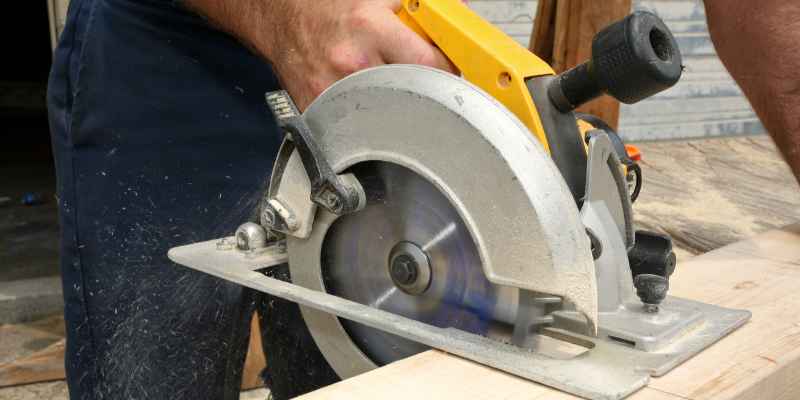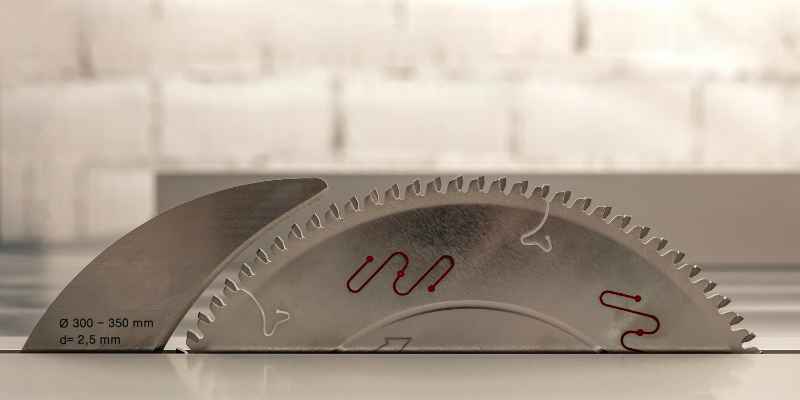When it comes to choosing between a circular saw and a drop saw, there are a few things you need to take into account. The type of project you’re undertaking, the material you’re working with, and your personal preferences will all play a role in which tool is best for the job. Circular saws are handheld power tools used for various tasks, from cutting through lumber to making precise cuts in sheet metal.
They typically have a blade guard that protects the operator from the spinning blade, and most models also have an adjustable depth stop so you can control how deep the cut goes. On the other hand, drop saws are extensive stationary tools explicitly designed for cutting lumber. The blade on a drop saw is much larger than that of a circular saw, making it better suited for long rip cuts.
Drop saws also have an enclosed base that helps keep dust and debris from flying around while you’re working.
A saw is an essential tool for anyone who works with wood or other materials. There are many types of saws available on the market, but two of the most popular are circular and drop saws. Both have advantages and disadvantages, so it’s essential to choose the right one for your needs.
Here is a quick rundown of each type of saw: A circular saw is a handheld power tool that uses a rotating blade to cut through the material. It’s ideal for making long, straight cuts in wood or other materials.
The main advantage of a circular saw is its portability – it can be easily carried around and used in different locations. Additionally, it’s relatively easy to use and can make clean, precise cuts. However, one downside is that it can be challenging to make curved or angled cuts with a circular saw.
Drop Saw: A drop saw (also known as a chop saw) is similar to a circular saw but has a fixed base that doesn’t move. This makes it more stable when cutting, which means you can achieve straighter and more accurate cuts than with a handheld circular saw. Drop saws also typically have larger blades than circular saws, which allows them to make more significant cuts.
However, they are less portable than circular saws and can be more challenging to set up.

Miter Saw Vs. Circular Saw for Beginners
Miter and circular saws are excellent tools for cutting wood, but they have different strengths and weaknesses.
Here’s a quick rundown of the key differences between these two types of saws:
Miter Saws:
– Miter saws are great for making precise cuts at angles. This makes them ideal for trim work, molding, and other jobs where accuracy is critical.
– Miter saws typically have smaller blades than circular saws, so they can’t cut through as much material at once.
However, this also means they’re less likely to kick back or bind when cutting.
– Miter saws usually need to be mounted on a table or stand to use them, which can be a bit of a hassle if you’re working on a small project.
Circular Saws:
– Circular saws can handle more material than miter saws because of their larger blades. This makes them better suited for big jobs like framing or deck building.
– Circular saw blades are more likely to bind or kick back than a miter saw blades, so you need to be extra careful when using one.
Always make sure your workpiece is securely clamped down before beginning any cut.
Circular Saw Vs. Skill Saw
There are a few key differences between a circular saw and a skill saw. The main difference is that a circular saw has a blade that spins around, while a skill saw has an edge that goes back and forth.
Here are some other key differences:
-A circular saw can cut through thicker materials than a skilled saw.
-A skill saw is more maneuverable than a circular saw, making it better for cutting curves.
-A circular saw is better for long, straight cuts, while a skill saw is better for shorter, more precise cuts.
Circular Saw Vs. Jigsaw
There are many types of saws on the market, and it can be hard to know which is suitable for your project. Two of the most popular saws are circular and jigsaws, but how do you know which one to choose? Here is a breakdown of the differences between these two types of saws to help you make the best decision for your next project.
Circular Saws: A circular saw is a powerful tool that uses a rotating blade to cut through materials. It is one of the most versatile tools in any shop and can be used for everything from ripping lumber to making crosscuts.
Circular saws typically have a large blade ranging from 7-1/4 inches to 10 inches. The size of the edge will determine how deep the cut can be.
Advantages:
-The most significant advantage of using a circular saw is that it can easily make long, straight cuts.
-They are also much more potent than jigsaws and can easily cut through thicker materials like plywood or 2x4s. -Another advantage is that most circular saws have an adjustable depth stop so you can control how deep the blade cuts into the material.
Disadvantages:
-One downside to using a circular saw is that it can be challenging to control, especially when making curved or angled cuts. They also create a lot of dust and debris, so it’s essential to wear eye and ear protection when operating one.
-Another disadvantage is that they require electricity or batteries, so they may not be suitable for use in remote locations where no power source is available.
Circular Saw Vs. Table Saw
The debate between circular saws and table saws has been around for years. There are pros and cons to both types of saws, and it comes down to personal preference regarding which one you use. Here, we’ll look at the key differences between these two types of saws so you can decide which one is right for you.
Circular Saws: -Are more diminutive and portable than table saws, making them ideal for job site work or working in small spaces. -Can be used with various blade sizes to accommodate different materials and applications.
-They typically have lower power than table saws, making them less suited for heavy-duty work. However, some high-end models pack plenty of power. Table Saws:
-Are larger and require more space to set up and operate. They’re not as portable as circular saws but can be moved if necessary.
Miter Saw Circular Saw Combo
Miter and circular saws are essential tools in a woodworker’s arsenal. They have unique advantages and disadvantages but can create impressive results when used together. A miter saw is designed for making cuts at angles, while a circular saw is better suited for making straight cuts.
However, combining the two tools allows you to create intricate designs and patterns that would be impossible to achieve with either device alone. There are a few things to remember when using a miter saw and circular saw combo. First, always use a sharp blade on your miter saw.
Second, take care not to over-cut the corners of your workpiece – this will make it challenging to fit the pieces together later on. And finally, practice makes perfect! The more you use these tools together, the better you’ll get at creating beautiful designs.
Circular Saw Chop Saw
Regarding home improvement projects, having the right tools can make all the difference. If you’re planning on doing any woodworking, a circular saw is an essential piece of equipment. But what if you need to make precision cuts or cut materials that are too thick for a standard circular saw?
That’s where a chop saw comes in. A chop saw is a circular saw on steroids. It’s designed for making quick, clean cuts through thick materials like lumber and metal pipes.
The blade on a chop saw is much larger and more powerful than on a standard circular saw, so it can handle more demanding jobs. And because the edge is fixed in place, it’s easier to make precise cuts with a chop saw than with a standard circular saw. If you’re planning on tackling big home improvement projects involving wood or metal, then a chop saw is an invaluable tool in your arsenal.
Circular Saw Vs. Miter Saw Vs. Table Saw
Woodworkers commonly use three main types of saws: the circular saw, the miter saw, and the table saw. Each type of saw has unique advantages and disadvantages that make it better suited for specific tasks. In this blog post, we’ll take a closer look at each type of saw and compare their features side-by-side to help you decide which is suitable for your next project.
Circular Saws: Advantages:
- Circular saws are very versatile and can be used for various tasks.
2. They are relatively inexpensive compared to other types of saws. 3. Circular saws are relatively easy to use once you get the hang of them.
Disadvantages:
- Circular saws can be dangerous if you’re not careful.
Make sure to read the safety instructions carefully before using one!
2. They require more skill than other types of saws (like the miter saw). This means they might not be ideal for beginner woodworkers or those who don’t have much experience using power tools.
Circular Saw Vs. Reciprocating Saw
When choosing between a circular and a reciprocating saw, there are a few things to consider. Both have pros and cons that make them better or worse for different applications. Here’s a rundown of key points to help you decide which suits your needs.
Circular Saw Pros:
– More potent than a reciprocating saw
– Can make long, precise cuts
– Easy to keep on track while cutting
Circular Saw Cons:
– Not as maneuverable as a reciprocating saw
– Requires two hands to operate
Is a Plunge Saw Better Than a Circular Saw?
There are a few key factors to consider when deciding if a plunge saw is better than a circular saw. The first factor is the type of project you’re working on. If you’re working on projects requiring precise cuts, a plunge saw is the better option.
Plunge saws allow you to make cleaner, more accurate cuts than circular saws. Another factor to consider is the depth of your stake. If you need to make deep cuts, a plunge saw will be better suited for the task.
Plunge saws can make deeper cuts than circular saws because they have longer blades. The last factor to consider is cost—plunge saws tend to be more expensive than circular saws.
So if cost is a significant consideration, a circular saw might be the better option.
Do I Need a Circular Saw And a Miter Saw?
If you’re wondering whether you need a circular or miter saw, the answer is: it depends. If you’re planning on doing a lot of woodworking or carpentry, then having both types of saws will give you more options and flexibility when cutting wood. However, if you only plan on occasional DIY projects around the house, then you might be able to get by with just a miter saw.
Here’s a closer look at each type of saw and what they’re typically used for: Circular Saws: A versatile tool that can be used for various tasks, including making long rip cuts, crosscuts, and even angled cuts. Circular saws typically have a blade that is 7-1/4 inches in diameter, although smaller and larger sizes are available.
One downside of circular saws is that they can be tricky to maneuver if you’re not experienced in using them. Miter Saws: Ideal for making precise cuts at different angles (hence the name “miter,” which comes from the word “mitered,” meaning cut at an angle). Miter saws come in two main types – compound miter saws which can make horizontal and vertical cuts, and standard miter saws, which can only make horizontal cuts.
Miter saws usually have blades that are 8 inches in diameter or less.
What is a Drop Saw Used For?
A drop saw, also known as a plunge or a power miter saw, is a type of circular saw designed to make quick, accurate cuts in wood. It is similar to a handheld circular saw, but the blade on a drop saw is mounted on an arm that can be raised and lowered, allowing the knife to be plunged into the material at the start of the cut. Carpenters and other woodworkers commonly use drop saws to make precise cuts in lumber and different types of wood.
The most common type of drop saw has a 14-inch diameter blade, but larger sizes are available for broader cuts. Some models also have laser guides that help keep the edge on track while cutting. While a drop saw can be used for many different amounts, it is particularly well-suited for making clean, straight cuts in lumber.
If you plan to do any woodworking project requiring precise cuts, then a drop saw would be an excellent tool in your workshop.

Are Circular Saws the Same As Miter Saws?
No, circular saws and miter saws are not the same. Both are types of power saws, but they have different purposes and use other blades. A circular saw has a round blade that rotates on an axis.
It is handheld and can be used for various tasks, such as cutting lumber, sheet metal, tile, and concrete. The depth of the cut is adjustable, so you can control how deep the blade cuts into the material. A miter saw also has a rotating blade, but it is mounted on a stand and has a fence to guide your fabric for accurate cutting at various angles.
It is mainly used for trim work or molding since it can make precise cuts. The blade on a miter saw can also be swiveled to make angled cuts (hence the name “miter,” which means angle).
Conclusion
When it comes to woodworking, there are two essential saws that you will need in your arsenal: the circular saw and the drop saw. But which one is better for the job? The main difference between these two types of saws is their blade.
A circular saw has a round blade that spins around, while a drop saw has a flat edge that oscillates back and forth. A drop saw can make more precise cuts than a circular saw. However, circular saws are more versatile because they can also be used for other tasks, such as cutting pipes and metal sheets.
They are also usually cheaper than drop saws. So, if you are starting in woodworking, a circular saw is probably the better option. However, a drop saw would be the better choice if you need to make precision cuts.



9 thoughts on “Circular Saw vs Drop Saw: Pros and Cons”